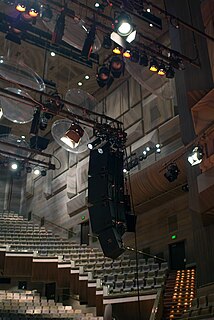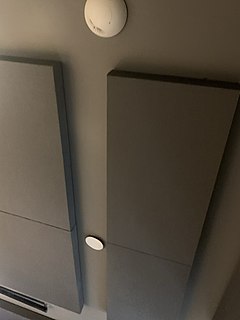
Acoustics is a branch of physics that deals with the study of mechanical waves in gases, liquids, and solids including topics such as vibration, sound, ultrasound and infrasound. A scientist who works in the field of acoustics is an acoustician while someone working in the field of acoustics technology may be called an acoustical engineer. The application of acoustics is present in almost all aspects of modern society with the most obvious being the audio and noise control industries.
Reverberation, in acoustics, is a persistence of sound, or echo after a sound is produced. Reverberation is created when a sound or signal is reflected causing numerous reflections to build up and then decay as the sound is absorbed by the surfaces of objects in the space – which could include furniture, people, and air. This is most noticeable when the sound source stops but the reflections continue, their amplitude decreasing, until zero is reached.
Room acoustics describes how sound behaves in an enclosed space. Sound of different frequencies behaves differently in a room. Reflections between walls, floor and ceiling create room modes at specific frequencies and locations. Reflections also produce reverberation.

Acoustical engineering is the branch of engineering dealing with sound and vibration. It includes the application of acoustics, the science of sound and vibration, in technology. Acoustical engineers are typically concerned with the design, analysis and control of sound.

Soundproofing is any means of reducing the sound pressure with respect to a specified sound source and receptor. There are several basic approaches to reducing sound: increasing the distance between source and receiver, using noise barriers to reflect or absorb the energy of the sound waves, using damping structures such as sound baffles, or using active antinoise sound generators.

Symphony Hall is a 2,262 seat concert venue in Birmingham, England. It was officially opened by the Queen on 12 June 1991, although it had been in use since 15 April 1991. It is home to the City of Birmingham Symphony Orchestra and hosts around 270 events a year. It was completed at a cost of £30 million. The hall's interior is modelled on the Musikverein in Vienna and the Concertgebouw in Amsterdam. The venue, managed alongside Town Hall, presents a programme of jazz, world, folk, rock, pop and classical concerts, organ recitals, spoken word, dance, comedy, educational and community performances, and is also used for conferences and business events as part of the International Convention Centre.

The Royal Festival Hall is a 2,700-seat concert, dance and talks venue within Southbank Centre in London. It is situated on the South Bank of the River Thames, not far from Hungerford Bridge, in the London Borough of Lambeth. It is a Grade I listed building, the first post-war building to become so protected. The London Philharmonic Orchestra, the Philharmonia Orchestra and the Orchestra of the Age of Enlightenment are resident in the hall.

The noise reduction coefficient is a single number value ranging from 0.0 to 1.0 that describes the average sound absorption performance of a material. An NRC of 0.0 indicates the object does not attenuate mid-frequency sounds, but rather reflects sound energy. This is more conceptual than physically achievable: even very thick concrete walls will attenuate sound and may have an NRC of 0.05. Conversely, an NRC of 1.0 indicates that the material provides an acoustic surface area that is equivalent to its physical, two-dimensional surface area. This rating is common of thicker, porous sound absorptive materials such as 2"-thick fabric-wrapped fiberglass panel. Materials can achieve NRC values greater than 1.00. This is a shortcoming of the test procedure and a limitation of how acousticians define a square unit of absorption, and not a characteristic of the material itself.
A reverberation chamber or room is a room designed to create a diffuse or random incidence sound field. Reverberation chambers tend to be large rooms and have very hard exposed surfaces. The change of impedance these surfaces present to incident sound is so large that virtually all of the acoustic energy that hits a surface is reflected back into the room. Arranging the room surfaces to be non-parallel helps inhibit the formation of standing waves - additional acoustic diffusers are often used to create more reflecting surfaces and further encourage even distribution of any particular sound field.
A sound attenuator, or duct silencer, sound trap, or muffler, is a noise control acoustical treatment of Heating Ventilating and Air-Conditioning (HVAC) ductwork designed to reduce transmission of noise through the ductwork, either from equipment into occupied spaces in a building, or between occupied spaces.
Sound Transmission Class is an integer rating of how well a building partition attenuates airborne sound. In the US, it is widely used to rate interior partitions, ceilings, floors, doors, windows and exterior wall configurations. Outside the US, the Sound Reduction Index (SRI) ISO index is used. The STC rating very roughly reflects the decibel reduction of noise that a partition can provide. The STC is useful for evaluating annoyance due to speech sounds, but not music or machinery noise as these sources contain more low frequency energy than speech.
Acoustic absorption refers to the process by which a material, structure, or object takes in sound energy when sound waves are encountered, as opposed to reflecting the energy. Part of the absorbed energy is transformed into heat and part is transmitted through the absorbing body. The energy transformed into heat is said to have been 'lost'.

Noise control or noise mitigation is a set of strategies to reduce noise pollution or to reduce the impact of that noise, whether outdoors or indoors.
Akoustolith is a porous ceramic material resembling stone. Akoustolith was a patented product of a collaboration between Rafael Guastavino Jr. and Harvard professor Wallace Sabine over a period of years starting in 1911.It was used to limit acoustic reflection and noise in large vaulted ceilings. Akoustolith was bonded as an additional layer to the structural tile of the Tile Arch System ceilings built by the Rafael Guastavino Company of New Jersey. The most prevalent use was to aid speech intelligibility in cathedrals and churches prior to the widespread use of public address systems.

Acoustic foam is an open celled foam used for acoustic treatment. It attenuates airbone sound waves, reducing their amplitude, for the purposes of noise reduction or noise control. The energy is dissipated as heat. Acoustic foam can be made in several different colors, sizes and thickness.

Acoustic transmission is the transmission of sounds through and between materials, including air, wall, and musical instruments.
Sound masking is the inclusion of generated sound into an environment to mask unwanted sound. It relies on auditory masking. Sound masking is not a form of active noise control ; however, it can reduce or eliminate the perception of sound. Sound masking is applied to an entire area to improve acoustical satisfaction, thus improving the acoustical privacy of the space. This can help an individual focus and thereby enhance productivity.
Acoustic quieting is the process of making machinery quieter by damping vibrations to prevent them from reaching the observer. Machinery vibrates, causing sound waves in air, hydroacoustic waves in water, and mechanical stresses in solid matter. Quieting is achieved by absorbing the vibrational energy or minimizing the source of the vibration. It may also be redirected away from the observer.
Acoustic plaster is plaster which contains fibres or aggregate so that it absorbs sound. Early plasters contained asbestos, but newer ones consist of a base layer of absorptive substrate panels, which are typically mineral wool, or a non-combustible inorganic blow-glass granulate. A first finishing layer is then applied on top of the substrate panels, and sometimes a second finishing layer is added for greater sound attenuation. Pre-made acoustic panels are more commonly used, but acoustic plaster provides a smooth and seamless appearance, and greater flexibility for readjustment. The drawback is the greater level of skill required in application. Proprietary types of acoustic plaster developed in the 1920s included Macoustic Plaster, Sabinite, Kalite, Wyodak, Old Newark and Sprayo-Flake produced by companies such as US Gypsum.

Acoustic panels are sound-absorbing fabric-wrapped boards designed to control echo and reverberation in a room. Most commonly used to resolve speech intelligibility issues in commercial soundproofing treatments. Most panels are constructed with a wooden frame, filled with sound absorption material and wrapped with fabric.














